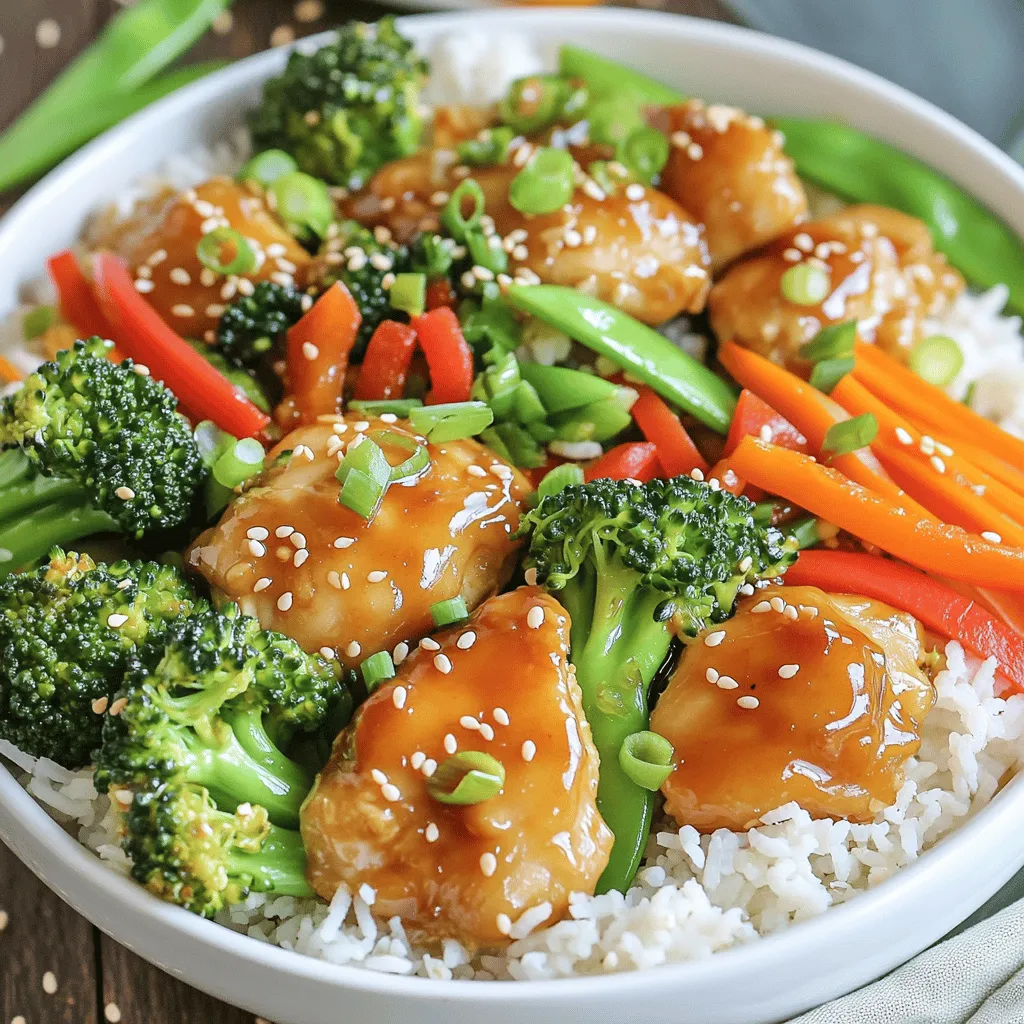Craving takeout but want something better? I’ve got just the recipe for you! My Better-Than-Takeout Sesame Chicken Bowls are a tasty twist on a classic. With juicy chicken, fresh veggies, and a homemade sauce, you’ll skip the restaurant and dine in style. Plus, I’ll share tips on marinating, perfect cooking times, and easy variations. Let’s make dinner fun and delicious, right in your kitchen!
Ingredients
Main Ingredients
– 1 pound boneless, skinless chicken thighs, cut into bite-sized pieces
– 3 tablespoons sesame oil
– 2 tablespoons soy sauce
– 1 tablespoon honey
– 1 tablespoon rice vinegar
– 3 cloves garlic, minced
– 1-inch piece ginger, grated
– 1 tablespoon cornstarch
– 1 cup broccoli florets
– 1 red bell pepper, sliced
– 1 carrot, julienned
– ½ cup snow peas
– Cooked jasmine rice or quinoa, for serving
For this recipe, I love using chicken thighs. They stay juicy and tender when cooked. The sesame oil adds a nice nutty flavor. Soy sauce brings that classic taste. Honey adds a touch of sweetness that balances the dish so well. Rice vinegar gives a bright note to the sauce. Garlic and ginger add depth and warmth. Cornstarch helps thicken the sauce and gives a lovely glaze to the chicken.
The vegetables add color and crunch. Broccoli, bell pepper, carrot, and snow peas are my favorites. They cook quickly and keep their shape. You can mix and match veggies based on what you like or have at home.
Optional Toppings
– Green onions
– Sesame seeds
For toppings, I recommend adding chopped green onions. They add a fresh crunch. Sesame seeds provide a nice nutty finish. You can sprinkle these on just before serving. They make the dish look pretty too!
Step-by-Step Instructions
Marinating the Chicken
To start, I combine the chicken pieces with soy sauce, honey, rice vinegar, minced garlic, grated ginger, and cornstarch in a bowl. This mix needs to coat each piece well. Marinating is key because it helps the chicken soak up all those tasty flavors. I let it marinate for at least 15 minutes. Longer is even better if you have the time.
Cooking the Chicken
I heat 1 tablespoon of sesame oil in a large skillet or wok over medium-high heat. Then, I add the marinated chicken to the pan. I cook the chicken for about 5 to 7 minutes. I watch carefully as it turns golden brown and cooks through. Once it’s done, I remove the chicken and set it aside, keeping it warm.
Stir-Frying the Vegetables
In the same skillet, I add the rest of the sesame oil. Now, it’s time for the veggies! I toss in broccoli, red bell pepper, carrot, and snow peas. These are my favorite combos for color and crunch. I stir-fry them for about 3 to 5 minutes. I make sure they stay tender-crisp, so they have that perfect crunch.
Combining Everything
Now, I return the cooked chicken to the skillet with the vegetables. I sprinkle sesame seeds over everything and stir it well. This blends all the flavors together. I give it another 2 minutes on the heat. This final step makes sure every bite is delicious. I serve it hot over a bed of cooked jasmine rice or quinoa. For an extra touch, I top it with chopped green onions and more sesame seeds if I like.
Tips & Tricks
Choosing the Right Chicken
– Boneless vs skinless: I always use boneless, skinless chicken thighs. They stay juicy and tender. Chicken breasts can dry out easily when cooked.
– Why thighs over breasts: Thighs have more fat and flavor. This makes them perfect for stir-fry. They soak up the marinade well, adding extra taste.
Making Ahead of Time
– Meal prep suggestions: You can marinate the chicken a day before. This saves time on busy nights. Just keep it in the fridge until you’re ready to cook.
– Marination tips: Aim for at least 15 minutes of marinating. The longer you marinate, the better the flavor. Try to use a sealed bag for even coating.
Perfecting Texture
– Cooking vegetables for crunch: Stir-fry the veggies quickly over high heat. This keeps them crisp and bright. I cook them for just 3-5 minutes.
– Balancing flavors: Add the sesame seeds at the end. They give a nice crunch and nutty taste. Make sure to mix everything well to blend the flavors.

Variations
Using Different Proteins
You can swap chicken for beef or tofu. Beef gives a robust flavor. Tofu offers a plant-based option. If using beef, cut it thinly for quick cooking. For tofu, press it to remove moisture first. Adjust cook time if you switch proteins. Beef may take a few extra minutes, while tofu fries faster.
Flavor Alterations
Change the taste by adding spices or sauces. Consider red pepper flakes for heat or hoisin sauce for sweetness. You can also add sesame oil for a richer flavor. If you like it sweeter, add more honey. Taste as you go to find the perfect balance.
Serving Alternatives
Try serving this dish with quinoa instead of jasmine rice. Quinoa is a great source of protein. If you want a low-carb option, use cauliflower rice. It mimics the rice texture without the carbs. You can also add extra veggies on top for more color and nutrients.
Storage Info
Refrigeration Tips
To store leftovers, place them in an airtight container. This keeps them fresh longer. Make sure the chicken and veggies are cool before sealing. You can keep them in the fridge for up to three days. If you want to enjoy them later, store them in small portions. This makes it easy to reheat just the right amount.
Freezing Instructions
To freeze your sesame chicken bowls, let them cool fully first. Transfer the chicken and veggies into freezer-safe bags. Squeeze out any air before sealing. This helps prevent freezer burn. You can freeze them for up to two months.
When you’re ready to eat, take them out and thaw overnight in the fridge. For reheating, warm them in a skillet over low heat. You can add a splash of water to keep them moist. Stir until everything is heated through. You can also use a microwave if you’re short on time. Just cover it to keep the steam in!
FAQs
Can I use chicken breasts instead of thighs?
Yes, you can use chicken breasts. They are lean and cook quickly. However, thighs have more flavor and stay juicy. If you choose breasts, watch cooking time. They may dry out if overcooked.
What vegetables can I substitute?
You can swap in many vegetables. Try bell peppers, snap peas, or zucchini. Carrots and broccoli work well, too. Use what you like or have on hand. Just cut them into similar sizes for even cooking.
How to make this dish gluten-free?
To make sesame chicken bowls gluten-free, use tamari instead of soy sauce. Tamari tastes similar and is safe for gluten-free diets. Also, check other brands for gluten-free labels. This way, everyone can enjoy it.
Can I add more spices for heat?
Absolutely! If you like heat, add red pepper flakes or chili paste. You can also use sriracha in the sauce. Start small, taste, and adjust as needed. This lets you find the right spice level for you.
What can I serve with sesame chicken bowls?
These bowls are great with jasmine rice or quinoa. You can also serve them with a side of steamed dumplings or spring rolls. For a fresh touch, add a simple salad to balance the meal.
The recipe provides a simple guide to making delicious sesame chicken bowls. You learned about key ingredients like chicken, vegetables, and sauces. I shared marinating tips and how to cook each component right. Choosing the right chicken and adding crunchy vegetables is crucial. You can customize flavors and even try different proteins. Remember, leftovers can be stored for easy meals. Keep practicing to perfect your skills and enjoy tasty results!


